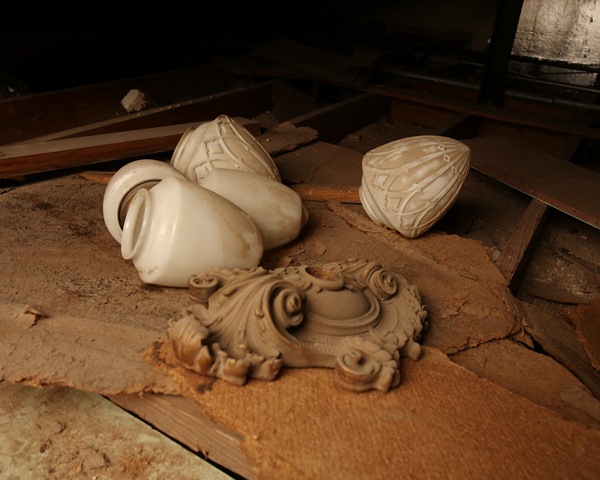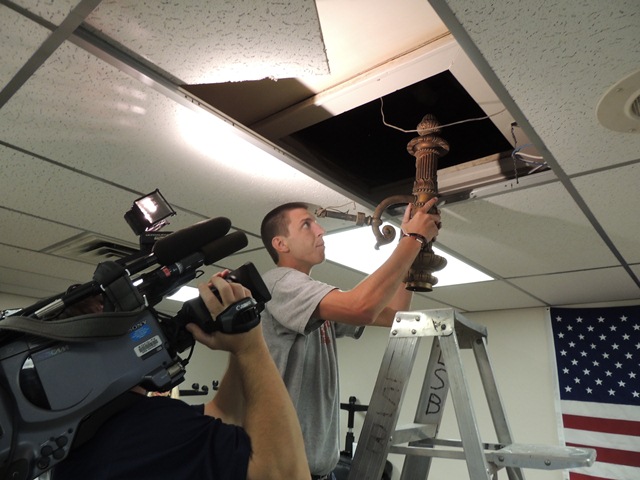Long-lost pieces discovered at State Capitol during Senate historical restoration project
 Historic light fixtures found in attic.
Historic light fixtures found in attic.
 Light globes found in attic.
Light globes found in attic.

(NOTE: High resolution versions available below)
Historic light fixtures found in attic.
Light globes found in attic.
Light fixtures brought out of attic.
High Resolution Photos:
Light fixtures found in attic
Light globes found in attic
Historical light fixtures being brought down from attic
Senate Chambers in 1918 with light fixtures
Long-lost pieces discovered at State Capitol during historical restoration project
Nearly one hundred years after beautifully ornate light fixtures were installed in the Senate Chamber, 11 of the original 20 fixtures have been discovered in attic space above the sixth floor of the Capitol. The artifacts were discovered during the ongoing historic restoration of a large conference room on the fifth floor that had been divided up into small offices decades ago. In connection with the project, Senate Information Systems Director John Warren was moving computer cables above the fifth floor ceiling and happened to notice an opening to a long-forgotten part of the attic. That led to the discovery of the fixtures.
Dr. Bob Blackburn, Executive Director of the Oklahoma State Historical Society said a black and white photo of the chamber from 1918 helped confirm they were the original fixtures, or sconces. He said the discovery was important for the historic preservation of the State Capitol, the symbol of unity for Oklahoma.
“When you think about our history, what connects the people in Cimarron County with the people of McCurtain County? What connects all of our communities together? The symbol is the State Capitol itself,” Blackburn said. “We don’t have an Alamo. We don’t have battlefields. We have the State Capitol.”
The discovery of the sconces comes just one year before the 100th anniversary of the groundbreaking for the Capitol, which was completed in 1917. Over the next several decades, numerous changes were made to the building, with little or no concern about the original architectural designs. Hallways, conference rooms and other spaces were turned into offices. Stained glass was hidden by lower ceilings installed to conceal air conditioning ducts and other modernizations. The original sconces were eventually replaced with fluorescent lighting.
In the late 1980’s, a major historic restoration project was undertaken during the administration of then-governor Henry Bellmon. A mini-grand staircase that had long been covered up and turned into offices, was uncovered and restored to help commemorate the centennial of the Land Run of 1889. Four years later Sen. Charles Ford led a project to restore the Senate Chamber.
“We looked and looked and looked when we restored the chamber in ’93, looking for these fixtures, or at least one of them,” said Ford. The search ended in disappointment.
Paul Meyer, managing member of M A+ Architecture, was the Capitol architect at that time. He called the discovery of the original Senate Chamber sconces “fantastic.”
“When we restored the Senate Chamber in 1993…we did not have the budget to replicate these light fixtures even though we had the original drawings,” Meyer said. “We replicated as closely as we could, but they weren’t anywhere near as magnificent as these are.
Trait Thompson serves as Vice Chair of the Capitol Preservation Commission, which was formed more than 30 years ago with the mission of overseeing the preservation and restoration of the building. He said finding the original sconces was one more important step in restoring the building.
“There is value in honoring the history of the State of Oklahoma,” Thompson said. “We have this beautiful building here that was completed in 1917 that really speaks to the spirit of Oklahoma. Any time you can restore any part of the building to its original condition, it’s a good thing.”
Blackburn noted other original pieces from the Senate Chamber, such as the floor lamps, still need to be found. He’s hopeful other artifacts will be discovered.
“Someone in 20 years may find something else,” Blackburn said. “Maybe in someone’s attic, maybe in someone’s garage or basement.”
But for now, he’s excited the sconces have been found. “At this one moment in time, we can reach out and touch one of the original pieces of the fabric of the building.”
 Oklahoma Senate
Oklahoma Senate

